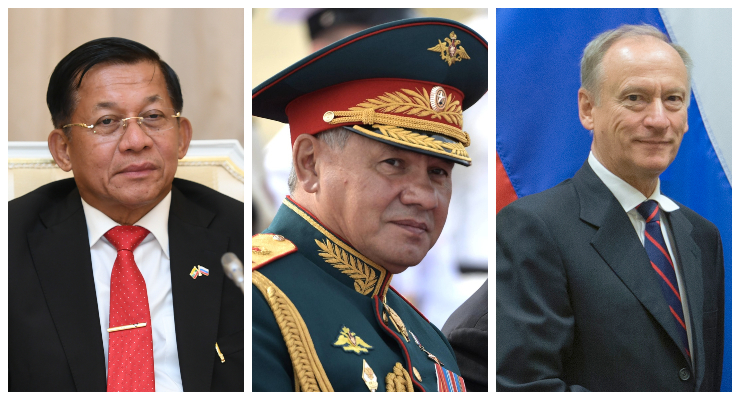
A fresh strategic headache has emerged for the Morrison government and its allies in the Indo-Pacific, with Russia making its presence felt in South-East Asia as it becomes increasingly cosy with the Myanmar junta.
Russia has been the generals’ most unqualified supporter since the February 1 coup d’etat and the relationship went to the next level when Myanmar chairman General Min Aung Hlaing recently flew to Moscow for an international military conference.
In his sixth visit since taking over the top job in Myanmar’s military, which is known as the Tatmadaw, he met with Russian Defence Minister Sergei Shoigu, who visited Myanmar last year, and Nikolai Patrushev, the secretary of Russia’s Security Council.
“We will create a new partnership, [and] will expand it. From the outset, our [military] cooperation was designed so that it would expand over time. That is why during that meeting, we were mostly discussing expanding the existing cooperation,” Min Aung Hlaing said following his trip.
A less-qualified relationship
While Moscow’s support for the junta has fallen short of a “full embrace” — Min Aung Hlaing was not afforded full head-of-state honours, according to reports — it is far less qualified than that from the country’s other big supporters China and India.
Russian arms sales to Myanmar — particularly in air power — have increased over the past decade as leaders in the capital Nay Pyi Taw have moved to decrease the country’s reliance on military equipment from China, its major supplier.
While Russia and China have joined to block any action by the United Nations Security Council against the coup’s leaders, China has continuing concerns about the increased instability it has bought to a country on its southern border and with which it is building a transport and energy corridor through to the Indian Ocean.
“The fast emergence of these militias, and their capacity to evolve from loosely coordinated groups of local people into more structured, better armed and sustainably funded forces, likely marks a new phase of Myanmar’s decades-old civil war,” the International Crisis Group warned in a June 28 report.
Russia’s presence in South-East Asia has been more subtle since it closed its naval base in the Vietnamese deep water port Cam Ranh Bay on the South China Sea in the early 2000s — one of the last relics of the Cold War.
Since then its presence in the region has not been “in your face” but nonetheless has remained quietly significant. Russia has very large diplomatic missions in all the major nations of the region: Singapore, Thailand, Malaysia, Indonesia, the Philippines and especially Vietnam, as well as in communist Laos and authoritarian Cambodia.
Strategic partner
Russia joined the East Asia Summit in 2011 and the relationship between Russia and the Association of South-East Asian Nations (ASEAN) was raised to the level of a strategic partnership in 2018, with the bilateral engagement of Russia in the region also accelerating.
Russia has also continued to work assiduously in cultivating its friendships, continuing its long history of providing education to people from most countries in the region, including countries of the former Indochina — Vietnam, Laos and Cambodia — but also, in particular, Indonesia.
And while it is the No. 2 arms exporter in the world after the US, it is the biggest arms exporter to the region where an escalating arms race has been taking place in recent years, largely due to the growing military might of China. Arms sales in South-East Asia increased by 5.7% against a global rise of 26%.
According to the Stockholm International Peace Research Institute (SIPRI), Russian arms sales to South-East Asia between 2010 and 2017 were US$6.6 billion, as much as the US and China combined. Since 2000, Russia has accounted for 25% of major arms sales in South-East Asia. Vietnam, Myanmar and Indonesia are Russia’s largest customers, as well as Laos and Malaysia.
For the increasingly authoritarian region, Russia offers better-priced weapons, other blandishments such as soft loans, state-backed credits and barter deals, and crucially doesn’t tie its sales to human rights — unlike its main arms rival the US.
Nowhere in the region right now is this more pertinent than Myanmar, where the junta is using Russian guns and bullets to murder its own citizens.
Analysts are expecting to see an increase in military exercises between Russia and Myanmar as well as increased Russian naval visits, allowing Moscow to increase its Indian Ocean presence.
In this way Russia’s presence — and its problem for Canberra — extends even beyond its longstanding alliance with Vietnam and opportunistic support for the Myanmar junta. It also poses something of a fly in the strategic ointment of the so-called Quad alliance (the Quadrilateral Security Dialogue) of the US, Japan, Australia and India. Russia is already the major arms supplier to India — considered the Quad’s weakest link — which is its single biggest customer, buying 23% of Russian arms between 2016 and 2020 according to SIPRI.
Simply put, the great power-plays in the Indo-Pacific have just become a bit more complicated.








To suggest the Yanks tie their arms sales to human rights is utterly laughable.
Tell it to the Yemenis, the Palestinians, the Syrians etc et freakin’ cetera, Sainsbury.
Exactly.
If only the Myanmar military were twice as corrupt then the CIA would have pushed the Russians out and embraced them for buying US arms.
Spare us the rant re Russia engaging with Myanmar or anywhere else until you start calling out the criminal USA war mongers & the evil regimes they support. Like all the tin pot dictators in Latin America etc . It’s a long list & the history is disgusting & over a very long time frame. I’ve been to Burma via Thailand some years ago & there’s no doubt that Australia should never have supported those Generals -but they did for trade & other reasons reasons.
Further more – https://tinyurl.com/8xehhzxc The Australian defence department plans to spend almost $400,000 on English lessons, event attendances and training courses for members of the Myanmar military in 2017-18, documents released under freedom of information laws show.The Defence department spend continues despite claims treatment of Rohingya bears ‘hallmarks of a genocide’
It is just pure media propaganda to be blaming China & Russia just because the USA demands support from its 5 eyes partners (in crime).
Ever visit John Menadue’s ‘Pearls & Irritations’, James?
I ask because you seem to exhibit a wider reading range.
For instance, a ripping piece today, from former multi-departmental careered (and Amb to the PRC), Dennis Argall.
It’s headed;
“The axis of evil shaping our minds, on China and more”, and begins;
“If ever there is now an axis of evil it is surely the uncoordinated journey of fellow travellers ASPI, now reportedly replacing DFAT as strategic advisor to government; Adrian Zenz, conservative Catholic inventor of Xinjiang genocide, who wants to see the overthrow of the government of China, and the ABC team led by Stan Grant, who have taken propagandistic reporting to unprecedented levels.”
And, includes;
“There is unfortunately now a major contradiction to the architecture for war avoidance: the behaviour of the United States in the unipolar war of the last four decades, become more vicious in recent times. You say what about Russia and Ukraine? I say, Malcolm Fraser. It’s actually the history stupid, not the histrionics.”
‘Talcum Malcolm’ 7 years ago, in the Grauniad;
“Ukraine: there’s no way out unless the west understands its past mistakes”.
The Yanks have tipped $1Billion worth of weapons into the UkroNazis coffers, just so they can fire them at their own Russian speaking citizens in the east of the nation.
And, just this week, the chiefs of the UkroNazi military dressed up their female service people in khaki and high heels – I kid you not.
And, they renamed a town/city a few kilometres from the ‘Eastern Front’; “New York”.
Didn’t the Yanks love that!
Hi David -thanks for that heads up & no I hadn’t heard of ‘Pearls & Irritations’. I have now & have just spent an hour reading some of the excellent articles there -all the ones you highlighted. Pity they don’t have responses as I’d like to at least tell those authors I appreciated their work. Seems to be real Journalism going on there – very unusual! 🙂 Some Crikey writers should visit for re-education.
Will swap you a link you may know about -excellent info re Russia & Ukraine etc — http://thesaker.is/
To claim that you “…hadn’t heard of ‘Pearls & Irritations’” shows how thoroughly you read other posts. (Sometimes I wonder whether you read your own, for all the sense they make.)
It is the go-to site regularly recommended by many here in want of adult opinion & analysis.
“It is the go-to site regularly recommended by many here in want of adult opinion & analysis.”
You’re nit picking again – obviously not adult enough to qualify. Show us all a post where YOU have recommended the site in question? Trying to appear clever – makes you look stupid. How’s that ?
It’s easy enough to search the archive – you’ll find that I’ve recommended P&I at least half a dozen times in the last couple of months, mostly when bewailing the poor profferings here.
where the junta is using Russian guns and bullets to murder its own citizens.* Does this idiot stick his head in the sand in regard to Ukraine.
This article has so many holes that I wished I never read it. It is whinge jounalism, written as if western post-colonial imperialism is not a thing and as if Burma was a pleasant democracy before the crackdown (when we supported them). Spare me!